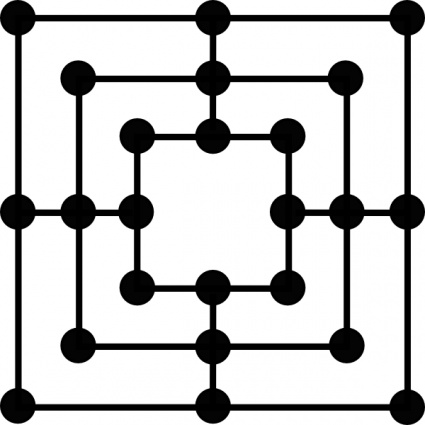*Read this in portguese: Português-BR
This is a pygame implementation of the classic game Nine Men´s Morris, also called Mill, Mills and even Cowboy Checkers.
First install pygame and numpy. This can be done with:
pip install -r requirements.txt
Then run the file main.py.
python run main.py
The game is played on this Board
There are 3 phases in the game:
In all phases the players can form mills by having three pieces in a row or a column, either by placing them or moving. Forming a mill allows for the removal of an opponent's piece. The winning condition is if a player has no legal move, or if a player is left with two pieces, however the game cannot end in phase one!
In this phase of the game, the players alternate in placing their pieces on the board. After each player has placed nine pieces, begins phase two of the game.
It is in phase two that the players now move the pieces they have previouly placed. A piece´s legal move is one to an empty adjacent tile.
Again, if a mill is formed, the player can remove a piece from the opponent.
If a player is left with only three pieces in phase two, it is said that the player is flying, and begins phase three, where the losing player can now move pieces to any empty tile, and not just adjacent ones. This gives this player an advantage, so as to not make the end game boring.
The game is played on the following board. which consists of 24 locations where the players can place and move pieces.
You can read more about the game at:
All implementation was built in Python 3.9 and the libraries used so far are:
- Numpy: used for some calculations.
- Pygame: used to create the game display and handle input events.
The project started with the base game with no interface whatsoever, and that's where I'll start explaning it.
The first thing I did was create a Nine Morris class to store the board, active player and the mills, and have functions to act on the board and read information from it.
The white player will be considered as being equal to 1 and the black player as -1. This will be stored in a player class. The numbers were choosen because it´s easy to chang the active player with active_player = -active_player.
class Player:
WHITE = 1
BLACK = -1The 24 positions of the board will be stored in a np.array of size 24, and will be labeled as follows.
Doing this means will have to know all possible mill configurations. This I have already done, and wrote in the file Possible Mills.
There are three types of possible moves, either you place a piece, move a piece or remove a piece. With this in mind, we´ll make the class MoveType
class MoveType:
PLACE_PIECE = 1
MOVE_PIECE = 2
REMOVE_PIECE = 3We´ll also have a class for the move itself, storing the position where the move will act upon, the type of move and, if it´s a piece movement, the final position of the piece.
class Move:
def __init__(self, position, move_type, final_position=None):
self.move_type = move_type
self.position = position
self.final_position = final_positionThis class also has a method to verify if the move is valid, a method to pretty print the move, and a method to hash it (more about this later).
The opponent's AI is built using the negamax algorithm which is a variant of the minimax algorithm where the score of one player is always considered to be the opposite of the other, which simplifies the logic.
In the minimax algorithm, the first step it to create a tree of all N (search depth) moves ahead. Then the best move is selected by going up the root where your move always maximizes your score and your opponent's always minimizes it.
My explanation of it is not maximized, so I suggest you watch Sebastian Lague's take on it. Video
My implementation uses alpha beta pruning and transpositions tables, which speed up the search when the depth is high. This is the reason why the moves and the board state need a hashing fuction.
The UI was built using a custom widgets' library for pygame I wrote, which can be accessed here. These include buttons, panels, text panels, text edits and more.
The main utility of pygame is in rendering the game and managing the game loop. The game loop is a function that runs at ~60Hz, and display all graphics, and handles inputs.
In pygame setting the framerate of a loop can be done with timer.tick(60) where timer is Clock object in the pygame.time module
My final gameloop looks like:
def run(self):
timer = pygame.time.Clock()
while self.running:
self.event_handler()
if self.active_window == Window.MENU:
self.menu()
elif self.active_window == Window.MATCH:
self.match()
elif self.active_window == Window.CONFIG:
self.config()
self.window_manager[self.active_window].show(self.window)
timer.tick(60)
pygame.display.update()Where the function self.event_handler takes care of all the user's input, such
as mouse and keyboard clicking.
The window manager is a dictionary storing all the windows in the game. This allows for easy on and off switching of all widgets.
- Add in game time.
- Add minimal (plus random number) time for AI to play.
- Ability to go back to the main menu once the game has started.
- Save a list a of the best first moves for depths higher than 4.

